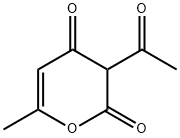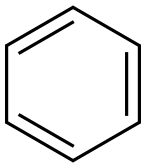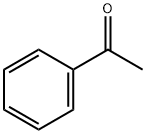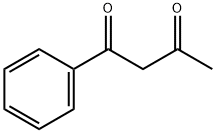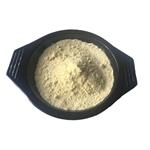Chemical Properties
Dehydroacetic acid is a white to cream-coloured powder that is only very slightly soluble in water (less than 0.1 %). However, the sodium salt hydrate (CSH7Na04.H20) has a solubility of 33% in water at 25°C, and 48% in propylene glycol. The acid is 22% soluble in acetone, 18% in benzene, and I g dissolves in about 35 ml of ethanol.It is used to reduce pickle bloating, and as a pesticide and preservative for squash and strawberries. Its permissible use level is 65ppm.
Dehydroacetic acid is one of the food additives found in red wine and was determined by ultra-fast liquid chromatography-tandem quadrupole mass spectrometry (UFLC-MS/MS).
To assay dehydroacetic acid, add 500 mg to a 250-ml Erlenmeyer flask and dissolve in 75 ml of neutral alcohol. Following the addition of phenolphthalein T.S., titrate with 0.1 N NaOH to a pink end-point that persists for at least 30 s. Each ml of 0.1 N NaOH = 16.82 mg of dehydroacetic acid (National Academy of Sciences, 1963).
Dehydroacetic acid is a synthetic chemical (no plant-based preservatives that meet our efficacy standards currently exist) that is considered to be a low hazard for human health and for the environment.
Uses
Dehydroacetic acid (DHS) is used as stabilizer for cosmetic and pharmaceutical products due to its fungicide and bactericide activity, as additive for PVC-stabilizers and for the syntheses of veterinary medicines. Product Data Sheet
Uses
antifungal, antibacterial
Uses
Dehydroacetic Acid (DHA) is a preservative that is a crystalline powder with a solubility of less than 0.1 g in 100 g of water at 25°C. It can undergo a variety of chemical reactions which give it utility in many applications. It is used at 0.01–0.5% for microbiological growth inhibition in various foods. It is used for cut or peeled squash, with no more than 65 ppm remaining in or on the prepared squash.
Uses
Geogard(R) 221 preservative is based on dehydroacetic acid (DHA) and benzyl alcohol, and therefore is recognized by major cosmetic, toiletry and fragrance regulatory authorities worldwide for use in cosmetic and personal care products.
Uses
Geogard(R) 361 preservative is based on six synergistic components, all with wide global regulatory acceptance: dehydroacetic acid (DHA); salicylic acid; benzoic acid; phenoxyethanol; benzyl alcohol; and benzethonium chloride.
Uses
dehydroacetic acid is a preservative with low sensitizing potential. This is a weak acid used as a fungi-and bacteria-destroying agent in cosmetics. The presence of organic matter decreases its effective ness. It is not irritating or allergy causing when applied on the skin.
Uses
Geogard(R) 111a preservative is based on dehydroacetic acid (DHA) and therefore are recognized by major cosmetic, toiletry and fragrance regulatory authorities worldwide for use in cosmetic and personal care products.
Definition
ChEBI: Dehydroacetic acid is a pyran-2,4-dione substituted at position 3 by an acetyl group and at position 6 by a methyl group. A fungicide and bactericide it is used primarily in processed fruit and vegetables. It has a role as a fungicide, an antibacterial agent and a plasticiser. It is a pyran-2,4-dione and a ketone.
Preparation
1) Dehydroacetic acid is prepared from Ethyl acetoacetate by self-condensation under mildly alkaline conditions (Sodium bicarbonate). 2) by polymerization of Ketene, obtained by thermal decomposition of Acetone).
Synthesis Reference(s)
The Journal of Organic Chemistry, 49, p. 5105, 1984
DOI: 10.1021/jo00200a018
General Description
Dehydroacetic acid is a pyrone derivative, that is typically synthesized by the base-catalyzed dimerization of diketene. It is used as a preservative in pharmaceutical, food and cosmetic products.
Pharmaceutical secondary standards for application in quality control, provide pharma laboratories and manufacturers with a convenient and cost-effective alternative to the preparation of in-house working standards.
Flammability and Explosibility
Not classified
Safety Profile
Poison by ingestion.
Moderately toxic by intraperitoneal route.
Questionable carcinogen with experimental
tumorigenic data. Combustible when
exposed to heat or flame. When heated to
decomposition it emits acrid smoke and
irritating fumes.
Solubility in organics
soluble in most hydrocarbons, but only about 3% soluble in alcohol and about 1.5% in Propylene glycol. Being an acid, it is soluble in aqueous alkali under formation of alkali salt .
